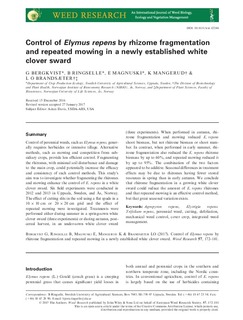Control of Elymus repens by rhizome fragmentation and repeated mowing in a newly established white clover sward
Journal article, Peer reviewed
Published version
Permanent lenke
http://hdl.handle.net/11250/2491730Utgivelsesdato
2017-03-14Metadata
Vis full innførselSamlinger
- Publikasjoner fra CRIStin - NIBIO [4575]
- Vitenskapelige artikler [1416]
Sammendrag
Control of perennial weeds, such as Elymus repens, generally requires herbicides or intensive tillage. Alternative methods, such as mowing and competition from subsidiary crops, provide less efficient control. Fragmenting the rhizomes, with minimal soil disturbance and damage to the main crop, could potentially increase the efficacy and consistency of such control methods. This study's aim was to investigate whether fragmenting the rhizomes and mowing enhance the control of E. repens in a white clover sward. Six field experiments were conducted in 2012 and 2013 in Uppsala, Sweden, and Ås, Norway. The effect of cutting slits in the soil using a flat spade in a 10 × 10 cm or 20 × 20 cm grid and the effect of repeated mowing were investigated. Treatments were performed either during summer in a spring-sown white clover sward (three experiments) or during autumn, post-cereal harvest, in an under-sown white clover sward (three experiments). When performed in autumn, rhizome fragmentation and mowing reduced E. repens shoot biomass, but not rhizome biomass or shoot number. In contrast, when performed in early summer, rhizome fragmentation also reduced the E. repens rhizome biomass by up to 60%, and repeated mowing reduced it by up to 95%. The combination of the two factors appeared to be additive. Seasonal differences in treatment effects may be due to rhizomes having fewer stored resources in spring than in early autumn. We conclude that rhizome fragmentation in a growing white clover sward could reduce the amount of E. repens rhizomes and that repeated mowing is an effective control method, but that great seasonal variation exists.

